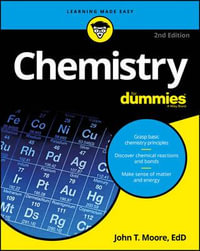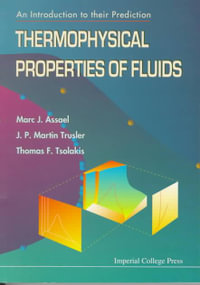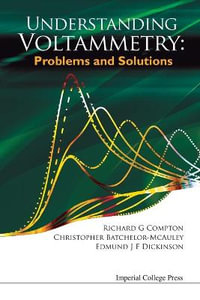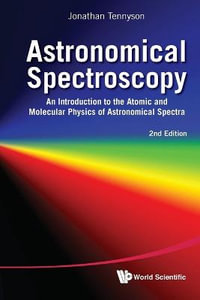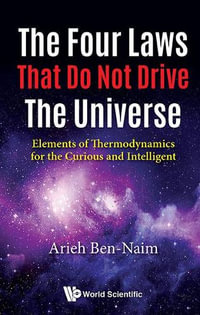
At a Glance
526 Pages
Revised
25.24 x 19.12 x 3.08
Hardcover
$351.15
or 4 interest-free payments of $87.79 with
orAims to ship in 7 to 10 business days
Preface v
Preface to the first edition vi
1 What this book is about and who should read it 1
1.1 How this book is organized 2
1.2 Scope and limitations 3
1.3 Context and further reading 3
1.4 On-line resources 4
1.5 Abbreviations and acronyms 4
2 Setting the scene 5
2.1 NMR frequencies and chemical shifts 5
2.2 Linewidths, lineshapes and integrals 9
2.3 Scalar coupling 10
2.4 The basic NMR experiment 13
2.5 Frequency, oscillations and rotations 15
2.6 Photons 20
2.7 Moving on 21
2.8 Further reading 21
2.9 Exercises 22
3 Energy levels and NMR spectra 23
3.1 The problem with the energy level approach 24
3.2 Introducing quantum mechanics 26
3.3 The spectrum from one spin 31
3.4 Writing the Hamiltonian in frequency units 34
3.5 The energy levels for two coupled spins 35
3.6 The spectrum from two coupled spins 38
3.7 Three spins 40
3.8 Summary 44
3.9 Further reading 44
3.10 Exercises 45
4 The vector model 47
4.1 The bulk magnetization 47
4.2 Larmor precession 50
4.3 Detection 51
4.4 Pulses 52
4.5 On-resonance pulses 57
4.6 Detection in the rotating frame 60
4.7 The basic pulse–acquire experiment 60
4.8 Pulse calibration 61
4.9 The spin echo 63
4.10 Pulses of different phases 66
4.11 Off-resonance effects and soft pulses 67
4.12 Moving on 71
4.13 Further reading 71
4.14 Exercises 72
5 Fourier transformation and data processing 77
5.1 How the Fourier transform works 78
5.2 Representing the FID 82
5.3 Lineshapes and phase 83
5.4 Manipulating the FID and the spectrum 90
5.5 Zero filling 99
5.6 Truncation 100
5.7 Further reading 101
5.8 Exercises 102
6 The quantum mechanics of one spin 105
6.1 Introduction 105
6.2 Superposition states 106
6.3 Some quantum mechanical tools 107
6.4 Computing the bulk magnetization 112
6.5 Summary 117
6.6 Time evolution 118
6.7 RF pulses 123
6.8 Making faster progress: the density operator 126
6.9 Coherence 134
6.10 Further reading 135
6.11 Exercises 136
7 Product operators 139
7.1 Operators for one spin 139
7.2 Analysis of pulse sequences for a one-spin system 143
7.3 Speeding things up 146
7.4 Operators for two spins 149
7.5 In-phase and anti-phase terms 152
7.6 Hamiltonians for two spins 157
7.7 Notation for heteronuclear spin systems 157
7.8 Spin echoes and J-modulation 158
7.9 Coherence transfer 166
7.10 The INEPT experiment 167
7.11 Selective COSY 171
7.12 Coherence order and multiple-quantum coherences 173
7.13 Summary 178
7.14 Further reading 179
7.15 Exercises 180
8 Two-dimensional NMR 183
8.1 The general scheme for two-dimensional NMR 184
8.2 Modulation and lineshapes 187
8.3 COSY 190
8.4 DQF COSY 200
8.5 Double-quantum spectroscopy 203
8.6 Heteronuclear correlation spectra 208
8.7 HSQC 209
8.8 HMQC 212
8.9 Long-range correlation: HMBC 215
8.10 HETCOR 220
8.11 TOCSY 221
8.12 Frequency discrimination and lineshapes 226
8.13 Further reading 236
8.14 Exercises 238
9 Relaxation and the NOE 241
9.1 The origin of relaxation 242
9.2 Relaxation mechanisms 249
9.3 Describing random motion – the correlation time 251
9.4 Populations 258
9.5 Longitudinal relaxation behaviour of isolated spins 263
9.6 Longitudinal dipolar relaxation of two spins 267
9.7 The NOE 274
9.8 Transverse relaxation 286
9.9 Homogeneous and inhomogeneous broadening 300
9.10 Relaxation due to chemical shift anisotropy 304
9.11 Cross correlation 306
9.12 Summary 311
9.13 Further reading 311
9.14 Exercises 313
10 Advanced topics in two-dimensional NMR 319
10.1 Product operators for three spins 320
10.2 COSY for three spins 325
10.3 Reduced multiplets in COSY spectra 330
10.4 Polarization operators 337
10.5 ZCOSY 345
10.6 HMBC 347
10.7 Sensitivity-enhanced experiments 349
10.8 Constant time experiments 353
10.9 TROSY 358
10.10 Double-quantum spectroscopy of a three-spin system 366
10.11 Further reading 374
10.12 Exercises 376
11 Coherence selection: phase cycling and field gradient pulses 381
11.1 Coherence order 382
11.2 Coherence transfer pathways 387
11.3 Frequency discrimination and lineshapes 389
11.4 The receiver phase 391
11.5 Introducing phase cycling 395
11.6 Some phase cycling ‘tricks’ 401
11.7 Axial peak suppression 403
11.8 CYCLOPS 403
11.9 Examples of practical phase cycles 404
11.10 Concluding remarks about phase cycling 408
11.11 Introducing field gradient pulses 409
11.12 Features of selection using gradients 416
11.13 Examples of using gradient pulses 421
11.14 Advantages and disadvantages of coherence selection with gradients 426
11.15 Suppression of zero-quantum coherence 426
11.16 Selective excitation with the aid of gradients 432
11.17 Further reading 435
11.18 Exercises 436
12 Equivalent spins and spin system analysis 441
12.1 Strong coupling in a two-spin system 442
12.2 Chemical and magnetic equivalence 446
12.3 Product operators for AXn (InS) spin systems 450
12.4 Spin echoes in InS spin systems 455
12.5 INEPT in InS spin systems 458
12.6 DEPT 462
12.7 Spin system analysis 468
12.8 Further reading 477
12.9 Exercises 478
13 How the spectrometer works 483
13.1 The magnet 483
13.2 The probe 485
13.3 The transmitter 486
13.4 The receiver 488
13.5 Digitizing the signal 489
13.6 Quadrature detection 491
13.7 The pulse programmer 493
13.8 Further reading 493
13.9 Exercises 494
A Some mathematical topics 495
A.1 The exponential function and logarithms 495
A.2 Complex numbers 497
A.3 Trigonometric identities 499
A.4 Further reading 500
Index 501
ISBN: 9780470746097
ISBN-10: 0470746092
Published: 14th May 2010
Format: Hardcover
Language: English
Number of Pages: 526
Audience: Professional and Scholarly
Publisher: John Wiley & Sons (UK)
Country of Publication: US
Edition Number: 2
Edition Type: Revised
Dimensions (cm): 25.24 x 19.12 x 3.08
Weight (kg): 1.4
Shipping
| Standard Shipping | Express Shipping | |
|---|---|---|
| Metro postcodes: | $9.99 | $14.95 |
| Regional postcodes: | $9.99 | $14.95 |
| Rural postcodes: | $9.99 | $14.95 |
How to return your order
At Booktopia, we offer hassle-free returns in accordance with our returns policy. If you wish to return an item, please get in touch with Booktopia Customer Care.
Additional postage charges may be applicable.
Defective items
If there is a problem with any of the items received for your order then the Booktopia Customer Care team is ready to assist you.
For more info please visit our Help Centre.





